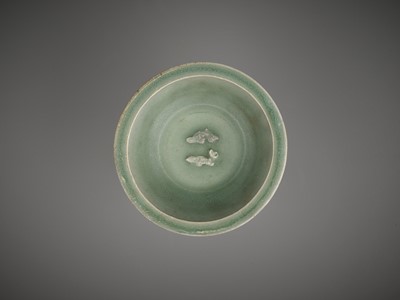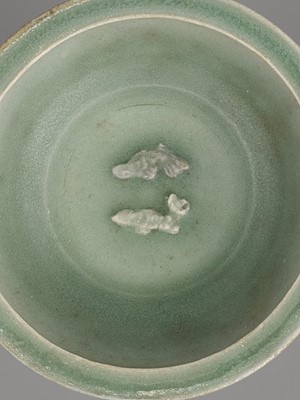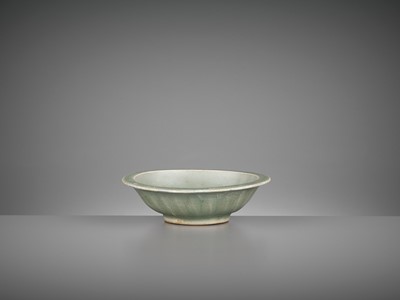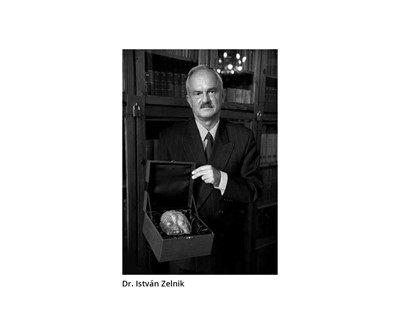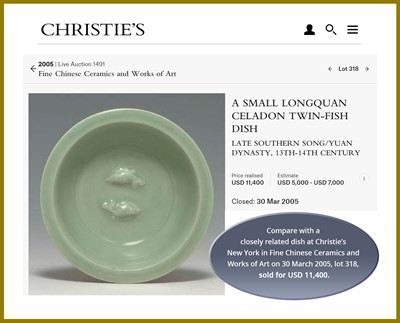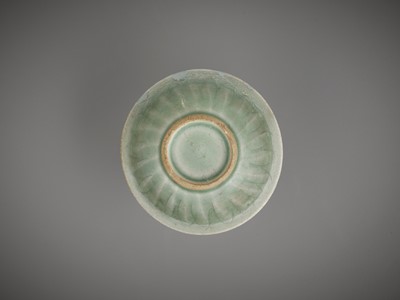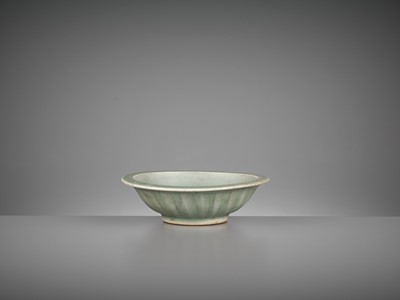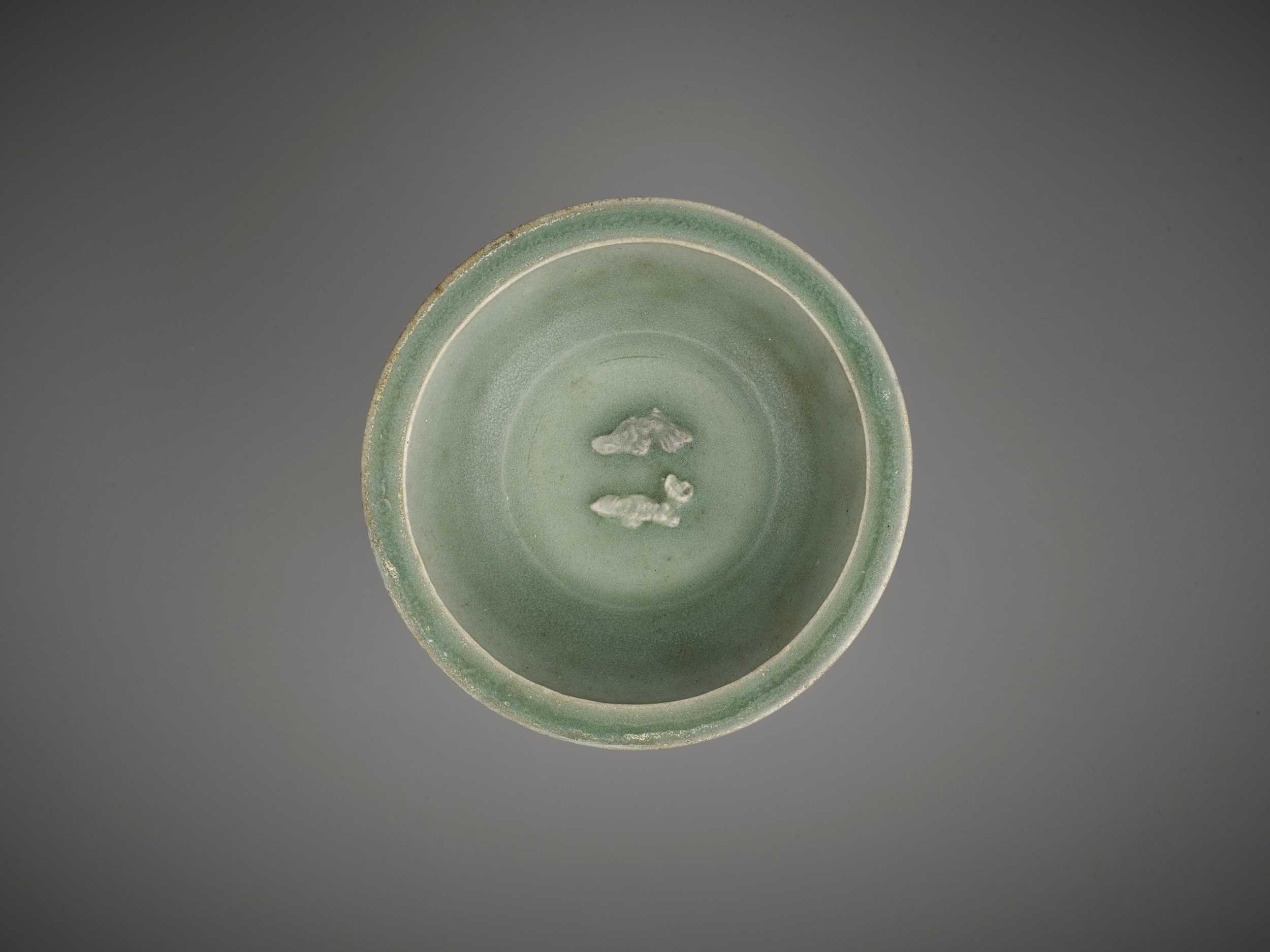5th Mar, 2021 10:00
TWO-DAY AUCTION - Fine Chinese Art / 中國藝術集珍 / Buddhism & Hinduism
184
A LONGQUAN CELADON ‘TWIN FISH’ DISH, LATE SOUTHERN SONG TO YUAN DYNASTY
宋末元初青釉雙魚盤
Sold for €1,074
including Buyer's Premium
China, 13th-14th century. The exterior of the deep rounded sides carved with a band of petals rising from the foot to the flat everted rim, and the interior decorated in the center with two molded fish, covered overall with a glaze of sea-green tone except for the foot rim burnt reddish-brown in the firing.
Provenance: Ex-Collection of The Zelnik István Southeast Asian Gold Museum. Institutional art collection in Belgium, acquired from the above. Dr. István Zelnik, President of the Hungarian South and Southeast Asian Research Institute, is a former high-ranking Hungarian diplomat who spent several decades in Southeast Asia, building the largest known private collection of Asian art in Europe.
Condition: Old wear, firing flaws, old repairs to rim, the glaze with erosion probably from saltwater.
Weight: 171.6 g
Dimensions: Diameter 12.7 cm
Paired fish symbolize fertility and connubial bliss, and they are also one of the Eight Buddhist symbols. Dishes of this type, known as ‘twin fish’ dishes, were popular products of the Longquan kilns during the late Southern Song to early Ming period.
Literature comparison: Similar Longquan celadon ‘twin fish’ dishes were recovered from the cargo of a trading vessel that sank off the coast of Sinan, South Korea, in the 1320s, and were included in the Special Exhibition of Cultural Relics Found off the Sinan Coast, National Museum of Korea, Seoul, 1977, pl. 28. Other examples are in the National Palace Museum, Taipei, included in Illustrated Catalogue of Sung Dynasty Porcelain in the National Palace Museum, Lung-chu'n Ware, Ko Ware and other Wares, Taipei, 1974, pl. 26, and in the Percival David Foundation, included in the Illustrated Catalogue of Celadon Wares, rev. ed., London, 1997, p. 27, no. 265.
Auction result comparison: Compare with a closely related dish at Christie’s New York in Fine Chinese Ceramics and Works of Art on 30 March 2005, lot 318, sold for USD 11,400.
宋末元初青釉雙魚盤
中國, 十三至十四世紀。深圓形側面,腹外壁飾蓮瓣紋。盤寬折沿,平底,盤內底貼首尾相對的模印雙魚。整體覆蓋有青綠色釉,脚緣露胎成紅褐色。
來源:The Zelnik Istvan Southeast Asian Gold Museum, 168頁,布達佩斯2013。這件拍品還將出現在即將出版的關於Zelnik博士先生收藏中的金銀器一書中,該書將於2021年出版。
圖片:Dr. István Zelnik
品相:舊磨損,燒制瑕疵,邊缘有舊的修復,釉面可能受鹽水侵蝕。
重量:171.6 克
尺寸:直徑12.7 厘米
拍賣結果比較:一件相近的盤,見紐約佳士得Fine Chinese Ceramics and Works of Art 拍場,2005年3月30日,lot 318, 售價USD 11,400
China, 13th-14th century. The exterior of the deep rounded sides carved with a band of petals rising from the foot to the flat everted rim, and the interior decorated in the center with two molded fish, covered overall with a glaze of sea-green tone except for the foot rim burnt reddish-brown in the firing.
Provenance: Ex-Collection of The Zelnik István Southeast Asian Gold Museum. Institutional art collection in Belgium, acquired from the above. Dr. István Zelnik, President of the Hungarian South and Southeast Asian Research Institute, is a former high-ranking Hungarian diplomat who spent several decades in Southeast Asia, building the largest known private collection of Asian art in Europe.
Condition: Old wear, firing flaws, old repairs to rim, the glaze with erosion probably from saltwater.
Weight: 171.6 g
Dimensions: Diameter 12.7 cm
Paired fish symbolize fertility and connubial bliss, and they are also one of the Eight Buddhist symbols. Dishes of this type, known as ‘twin fish’ dishes, were popular products of the Longquan kilns during the late Southern Song to early Ming period.
Literature comparison: Similar Longquan celadon ‘twin fish’ dishes were recovered from the cargo of a trading vessel that sank off the coast of Sinan, South Korea, in the 1320s, and were included in the Special Exhibition of Cultural Relics Found off the Sinan Coast, National Museum of Korea, Seoul, 1977, pl. 28. Other examples are in the National Palace Museum, Taipei, included in Illustrated Catalogue of Sung Dynasty Porcelain in the National Palace Museum, Lung-chu'n Ware, Ko Ware and other Wares, Taipei, 1974, pl. 26, and in the Percival David Foundation, included in the Illustrated Catalogue of Celadon Wares, rev. ed., London, 1997, p. 27, no. 265.
Auction result comparison: Compare with a closely related dish at Christie’s New York in Fine Chinese Ceramics and Works of Art on 30 March 2005, lot 318, sold for USD 11,400.
宋末元初青釉雙魚盤
中國, 十三至十四世紀。深圓形側面,腹外壁飾蓮瓣紋。盤寬折沿,平底,盤內底貼首尾相對的模印雙魚。整體覆蓋有青綠色釉,脚緣露胎成紅褐色。
來源:The Zelnik Istvan Southeast Asian Gold Museum, 168頁,布達佩斯2013。這件拍品還將出現在即將出版的關於Zelnik博士先生收藏中的金銀器一書中,該書將於2021年出版。
圖片:Dr. István Zelnik
品相:舊磨損,燒制瑕疵,邊缘有舊的修復,釉面可能受鹽水侵蝕。
重量:171.6 克
尺寸:直徑12.7 厘米
拍賣結果比較:一件相近的盤,見紐約佳士得Fine Chinese Ceramics and Works of Art 拍場,2005年3月30日,lot 318, 售價USD 11,400
Zacke Live Online Bidding
Our online bidding platform makes it easier than ever to bid in our auctions! When you bid through our website, you can take advantage of our premium buyer's terms without incurring any additional online bidding surcharges.
To bid live online, you'll need to create an online account. Once your account is created and your identity is verified, you can register to bid in an auction up to 12 hours before the auction begins.
Intended Spend and Bid Limits
When you register to bid in an online auction, you will need to share your intended maximum spending budget for the auction. We will then review your intended spend and set a bid limit for you. Once you have pre-registered for a live online auction, you can see your intended spend and bid limit by going to 'Account Settings' and clicking on 'Live Bidding Registrations'.
Your bid limit will be the maximum amount you can bid during the auction. Your bid limit is for the hammer price and is not affected by the buyer’s premium and VAT. For example, if you have a bid limit of €1,000 and place two winning bids for €300 and €200, then you will only be able to bid €500 for the rest of the auction. If you try to place a bid that is higher than €500, you will not be able to do so.
Online Absentee and Telephone Bids
You can now leave absentee and telephone bids on our website!
Absentee Bidding
Once you've created an account and your identity is verified, you can leave your absentee bid directly on the lot page. We will contact you when your bids have been confirmed.
Telephone Bidding
Once you've created an account and your identity is verified, you can leave telephone bids online. We will contact you when your bids have been confirmed.
Classic Absentee and Telephone Bidding Form
You can still submit absentee and telephone bids by email or fax if you prefer. Simply fill out the Absentee Bidding/Telephone bidding form and return it to us by email at office@zacke.at or by fax at +43 (1) 532 04 52 20. You can download the PDF from our Upcoming Auctions page.
How-To Guides
How to Create Your Personal Zacke Account
How to Register to Bid on Zacke Live
How to Leave Absentee Bids Online
How to Leave Telephone Bids Online
中文版本的操作指南
创建新账号
注册Zacke Live在线直播竞拍(免平台费)
缺席投标和电话投标
Third-Party Bidding
We partner with best-in-class third-party partners to make it easy for you to bid online in the channel of your choice. Please note that if you bid with one of our third-party online partners, then there will be a live bidding surcharge on top of your final purchase price. You can find all of our fees here. Here's a full list of our third-party partners:
- 51 Bid Live
- EpaiLive
- ArtFoxLive
- Invaluable
- LiveAuctioneers
- the-saleroom
- lot-tissimo
- Drouot
Please note that we place different auctions on different platforms. For example, in general, we only place Chinese art auctions on 51 Bid Live.
Bidding in Person
You must register to bid in person and will be assigned a paddle at the auction. Please contact us at office@zacke.at or +43 (1) 532 04 52 for the latest local health and safety guidelines.
